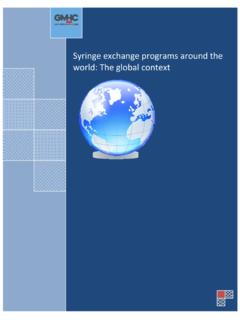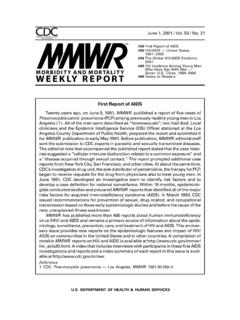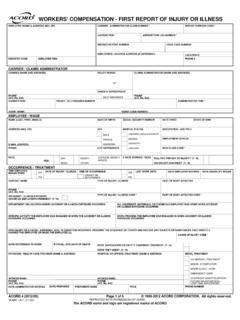Transcription of HIV Risk for Lesbians, Bisexuals & Other Women Who Have ...
1 HIV Risk for Lesbians, Bisexuals & Other Women Who Have Sex With WomenJune 2009 Gay Men s Health Crisis 1 The objective of this paper is not to argue that lesbians/WSW are at the same risk as their heterosexual counterparts, but to acknowledge that there is significant risk of HIV, Other STIs, and Other health disparities for lesbiansIntroductionThe vulnerability of lesbians and Women who have sex with Women (WSW) to HIV infection is a complicated public health issue that is perplexing to some and ignored by many. In fact, female-to-female sexual contact is a much less efficient route of HIV transmission when compared to male/male or male/female sexual contact. According to the CDC, there are no confirmed cases of HIV from female-to-female transmission. With more than 15 years of experience with lesbians and WSW, the Lesbian aids Project (LAP) at Gay Men s Health Crisis (GMHC) knows first hand that there are lesbians and WSW living with HIV. We set about to research the risks lesbians and WSW face in this, the third decade of the HIV epidemic.
2 This research indicates that some lesbians/WSW engage in high risk behaviors that place them at risk for HIV transmission. Some WSW use injection drugs and may share needles and works. Some WSW have sex, or sexual histories, with HIV-positive men and/or injection drug users. Furthermore, our observations in LAP also suggest that WSW of color in New York City experience a number of environmental adversities that drive risk and confound expectations based solely on their sexual orientation. Lesbians, long ignored in HIV prevention and service programs, need and deserve tailored interventions and better health outcomes. Beyond that, the examination of the HIV and health risks lesbians face is an examination of the intersection of sexual health, sexuality, identity and stigma in public health programming and policy. This examination yields lessons that should be review of the literature makes the case that the risk of contracting HIV is directly related to a woman s experiences and behaviors.
3 The objective of this paper is not to argue that lesbians/WSW are at the same risk as their heterosexual counterparts, but to acknowledge that there is significant risk of HIV, Other STIs, and Other health disparities for lesbians. These risks are exacerbated by racial disparities in health care access, as well as by homophobia, sexism, and stigma. Furthermore, this paper seeks to clarify confusion regarding lesbians and WSW risk in order to create visibility for this marginalized subpopulation of Women . Prevention and policy interventions must reach more deeply into communities of Women and take into account the context of their lives. 2 HIV Risk for Lesbians, Bisexuals & Other Women Who Have Sex With WomenFor the purposes of this paper, we will define lesbians simply as homosexual Women , or Women who have sexual desire and relationships with Other Women . WSW are Women who have, or have had, sex with Women who may or may not self-identify as order to understand the context of risk for lesbians and WSW, we must understand the context of HIV among Women .
4 A woman s risk of contracting HIV is directly related to her experiences and behaviors, which cannot solely be determined by the use of labels commonly used to identify an individual s sexuality and sexual & HIV: The contextNew surveillance technology developed by the Centers for Disease Control & Prevention, confirmed what many in the HIV and aids service fields have suspected for a long time: The HIV epidemic is, and has been, worse than previously known. Results announced in August 2008 indicate that approximately 56,300 new HIV infections occurred in the United States in 2006. This figure is roughly 40% higher than CDC s former estimate of 40,000 infections per year. Women account for more than one quarter of all new HIV/ aids diagnoses. (CDC, 2008) Women of color are especially affected by HIV infection and aids . In 2004, HIV infection wasThe leading cause of death for black Women aged 25 34; The third leading cause of death for black Women aged 35 44; The fourth leading cause of death for black Women aged 45 54; The fourth leading cause of death for Hispanic Women aged 35 44; In the same year, HIV infection was the fifth leading cause of death among all Women ages 35 44 years and the sixth leading cause of death among all Women aged 25 34 years.
5 The only diseases causing more deaths of Women were cancer and heart disease. (CDC, 2008)Though the annual estimated rate of HIV diagnoses for black Women decreased significantly from per 100,000 in 2001 to per 100,000 in 2005 it remained 20 times the rates for white Women . Overall, the rates of HIV diagnosis are much higher for black and Hispanic Women than for white, Asian and Pacific Islander, or American Indian and Alaska Native Women . The rates for black Women are higher than the rates for all men except black men. (CDC, 2008)Lesbians and bisexual Women , like their heterosexual counterparts, engage in at-risk sexual and social behaviors that place them at high risk, including but not limited to: unprotected sex with men, an increased number of sexual partners, the use of injection Gay Men s Health Crisis 3drugs, and exposure to fluids known to transmit HIV menstrual blood, vaginal secretions. Research from 1992 has shown that while a number of Women (81%) believe that safe sex is important, only a few ( ) actually practiced it when engaged in sexual activity with Other Women (Russell et al.)
6 1992). More than a decade later, this continues to be a reality for a many transmissionWhile lesbians and WSW are at relatively low risk of HIV infection, lesbian sex is not risk free. In 2006, the CDC issued a report stating that there were no confirmed cases of HIV from female-to-female transmission (CDC, 2006). However, the CDC did acknowledge that there have been several documented cases of Women who have sex with Women that have been infected with HIV. One such individual, a 20-year-old African-American woman, revealed that while she contracted the HIV virus, she did not have a history of the typical signs of risk behavior. She had never engaged in sexual intercourse with a man, did not use injection drugs or Other substances, had no tattoos or piercings and had received no blood transfusions. Her only partner was a bisexual female who had HIV. It was concluded that the regular use of sex toys contributed to the contraction (Ghobrial, 2003).
7 To date, much of the information on female-to-female transmission fails to mention that unprotected oral sex can involve HIV risk if the pleasure provider engages in cunnilingus while the recipient of the pleasure is in the beginning, middle, or end stage of her menstrual period, the woman performing oral sex can be at risk for HIV transmission. In addition, the presence of a large amount of vaginal secretions during oral sex can also pose a risk of female-to-female transmission. HIV, aids and STI prevention education should seek to debunk myths surrounding the female-to-female transmission. Lesbians and Other Women who have sex with Women have been forced to remain in the closet of silence and shame about their risks and their HIV status. Much of this has had to do with the ways in which sexual minority groups are overlooked in the epidemic, and the assumption on the part of health care providers that Women who have sex with Women are at little to no risk for HIV transmission.
8 Three sexual activities were labeled by the National aids Manual (NAM) to be high risk behaviors for HIV. They included oral sex, sharing sex toys and fisting (Farquhar et al., 2001). Actual documented cases of HIV transmission through these activities are In the book, Getting Unstuck, the main character describes, what she believes to have been the way that she, as a woman who exclusively had sex with Women , became infected with HIV: Oral sex with open fever blisters on my mouth and fingers penetration with open cuts on my fingers and hands. The cuts on my hands caused by the glass dick [the crack pipe] constantly breaking, and the Other open wounds on my hands caused by handling cocaine without any protection. What made it worse was bled during finger penetration because nails scratched and pierced the tissue lining along the walls of her vagina during rough sex. It only takes one open cut on a finger to become vulnerable to the virus. 4 HIV Risk for Lesbians, Bisexuals & Other Women Who Have Sex With Womenvery few, if any at all.
9 The focus on the use of oral protective barriers has been given too much weight. Some critics note that emphasizing oral protective barriers can be misleading, and that more effort should be focused on Other sexual practices that place Women at greater risk, such as fisting and sharing sex toys without first disinfecting them (James, 1995). A study conducted by the Lesbian aids Project at Gay Men s Health Crisis in 1992 93 involving 1200 WSW revealed that nearly half of the respondents shared sex toys without the use of protective barriers, and 80% reported that they had never used a barrier when engaging in oral sex (Montcalm and Myer, 2000). Roughly one out of every four Women reported oral sex with a menstruating partner in the absence of a protective barrier. More than 25% of the Women indicated that they did not possess an adequate level of knowledge about practicing safe sex for self protection (Montcalm and Myer, 2000). Further, a Kaiser Network published a report that stated 20% of WSW reported sexual play that involved blood exposure and 26% had been diagnosed with an STI (Kaiser, 2001).
10 Approximately one third of the Women in the study reported that they had a male sexual partner. 84% of the Women believed that they were at zero risk for HIV and STI s, despite the fact that most of the Women engaged in multiple episodes of unprotected sex every month that involved potential exchange of vaginal secretions, blood and semen (Kaiser, 2001).Little research has been devoted to the study of lesbian/WSW sexual play. Sexual practices that include genital-to-genital rubbing, sex play with toys absent of protective barriers, stimulation of genital/anal areas with hands and mouth, and Other sex play that involves fluid exchange needs further study. The relationship between what constitutes sex between Women and Women s risk of HIV certainly deserves more attention. A Lesbian Sexual Health and Behavior survey from London found that of the 91% of Women who had performed oral sex on another female, only 14% reported using dental dams and only 1% stated that they had always used dental dams (Farquhar, 2001).





